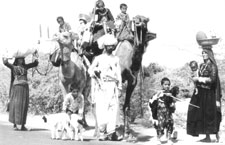
Dimdima
Online Children's Magazine from India

Dimdima
Online Children's Magazine from India

In Europe, the wolf is the only large carnivore found in the wild. Since the Middle Ages, people here have had an uneasy relationship with the wolf. They believed in the existence of werewolves — humans who used to change into wolves on full moon nights. All over Europe, the wolf came to symbolise all that was evil. People knew, and still know, very little about the habits of wolves. Some believed that the animals have poisonous fangs! Thus, wolves were slain in large numbers. In England, France and Germany, wolves were exterminated completely. The species was placed under protection and a small number has managed to survive in the Montesinho National Park in Portugal. However, the villagers living in the vicinity of the park still have a troubled relationship with the wolf.
Cattle rearing is an important occupation and the wolf is considered an enemy of livestock. The villagers even resorted to poisoning entire wolf packs. They set their dogs after them or scare them away with firebrands. Due to centuries of such persecution, the wolves have developed a strong fear of humans.
In India, in the Sariska Tiger Reserve in Rajasthan, villagers have a completely different attitude towards wildlife, mainly the tiger. Within the 800 sq km reserve, about 20 tigers, a few panthers and thousands of large herbivores, such as nilgai, sambar and wild boar, coexist with 16 villages.
In Haripura village, there are about 150 people of the Gujjar community. Their houses are made of indigenous materials. There is no electricity, running water or toilets in these villages. Each family keeps buffaloes. They earn about Rs 2,000-4,000 a month from selling milk. Milk, cereals and vegetables form their basic food. They also pick wild grain and fruit, such as ber. They use small quantities of firewood, preferring dead branches gathered from the forest. Fences of thorny branches are their only protection against tigers.
Buffaloes share the natural pastures with wild herbivores. The villagers believe that such association is not competitive. The villagers also feel wild herbivores act as a buffer against cattle-lifting by predators. They understand the role of large carnivores in the environment.
“If there were no tigers or panthers, there would be too many sambar and nilgai and so one day there would be no grass or trees. There would be no forest,” they say.
The villagers are careful and silent in the jungle and never come between a tiger and its prey, even if it is a buffalo. In the past 14 years only one person — an outsider who ignored the rules — was killed by a tiger in the reserve. Cases of people wounded by tigers are also very rare. As the villagers say, “If you live here, you must accept the risks.” At the temples in Haripura, villagers have an altar with a sculpture of a tiger head, which they worship.
Instead of trying to completely dominate their environment, the villagers have adapted to it, integrating themselves successfully with the fauna of the region and preserving it. Many traditional Indian societies had similar relationships with the environment in the past till colonial times, when the British and the upper classes killed thousands of tigers.
The story of Haripura shows that people and wildlife need not be kept isolated from each other. As long as each respects the other's domain, there is no conflict, only harmonious co-existence.
Last updated on :9/28/2004
EXPLORE MORE...
COMMENT ON THIS ARTICLE
Wants to share something related to this article? Please use the form below.
Dimdima is the Sanskrit word for ‘drumbeat’. In olden days, victory in battle was heralded by the beat of drums or any important news to be conveyed to the people used to be accompanied with drumbeats.
Bharatiya Vidya Bhavan
K. M Munshi Marg,
Chowpatty, Mumbai - 400 007
email : editor@dimdima.com
Bharatiya Vidya Bhavan
505, Sane Guruji Marg,
Tardeo, Mumbai - 400 034
email : promo@dimdima.com
Dimdima.com, the Children's Website of Bharatiya Vidya Bhavan launched in 2000 and came out with a Printed version of Dimdima Magazine in 2004. At present the Printed Version have more than 35,000 subscribers from India and Abroad.